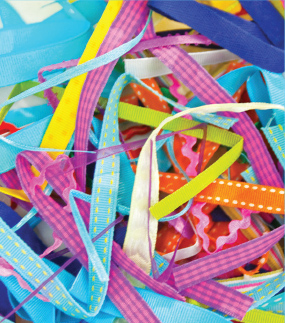Ribbons have countless functions and can be made of silk, velvet, cotton, satin, jute, sheer, organza, polyester, nylon and grosgrain materials. Not only are there many different kinds of ribbons, but they are universal! They're found all around the world in hair and on clothes, tied around packages and to decorate animals and buildings. Ribbons have a long tradition of excellence, ornamentation and fun.
The history of ribbons
Ribbons were first woven more than a thousand years ago, in France. What makes a ribbon loom so special is how more than one fabric can be woven into a web at once. Looms that can do this are very sophisticated, which is why ribbons are a relatively modern invention. But soon, each nation in medieval Europe had its own ribbon-weaving center. In Krefeld, Germany, for example, they specialized in black velvet ribbon. In Leiden, Netherlands, in the 16th century, weavers caused riots because of the specialty of these ribbon-looms over their own. As a result, ribbon-looms were banned from use. It wasn't until 1745 that improvements in the ribbon loom led to a shared usage for weavers at large, and ribbon-weaving became more common.
Although ribbon has been used in lingerie for centuries, it wasn't until about twenty years ago that the fashion industry started to really make use of ribbon in everyday wear. As a result of high demand, much of the world's ribbon production moved to China, where production costs were lower and quality could remain high.
Ribbons as decoration
In the ancient world, architectural ornamentation was carved from stone. Today's architecture, uses different kind of ornamentation thanks to glass and steel. But rosettes, stylized flowers with petals radiating outward, have moved away from the outside of buildings to the inside. Rosettes are commonly made with satin ribbon. Folded satin ribbon looks like the leaves of a flower, and while it's still common to see rosettes in metalwork, woodwork and stone, it's much more common to see them given as prizes, such as in the traditional first place blue ribbon awarded at 4H Clubs around the U.S.
The Blue Ribbon
The blue ribbon, or riband, as it is spelled in other English-speaking countries around the world, dates back to the fastest Atlantic Ocean ship crossing during the early 20th century. But even before that, the blue ribbon symbolized excellence. It started with the Cordon Bleu, not the chicken, but a medieval order of knights called the Order of the Holy Spirit. This order, and many others like it, used ribbons to denote their members. In the late 16th century, knights, princes and other noblemen from all over France were awarded membership to this order to ensure their loyalty to the crown. Due to the blue ribbon that the seal of the order hung from, these knights were known as Les Cordon Bleu, which eventually came to represent a very high standard in cooking, sports and other prestigious events.
Ribbon symbolism
Over the years, many ribbons have acquired a symbolic significance. Blue isn't the only color associated with medals and membership to an elite club. Today, most people wear ribbons to show support for a cause or to raise awareness. Yellow ribbons support armed forces, pink ribbons are for breast cancer, and red is for AIDS. This practice is relatively young, since it started during WWI, so different striped or colored ribbons continue to take on new meaning every day.
While ribbons are rich culturally, they're also perfect for crafts and projects, and kids love them too. Satin ribbons can make anything look more beautiful, especially when draped or tied around ordinary glass or vases. They're perfect for wedding invitations or the ceremony, to wear in place of a belt, and to decorate for the season. Ribbons can also be used as permanent fixtures when folded into flowers or made into ties. And ribbon-cutting ceremonies are still commonly performed to inaugurate a new business or service. How will you use your ribbon? The choices are endless, and if you have a great idea, feel free tell us by e-mail or in a comment on our blog!

